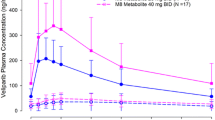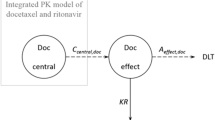Abstract
The thymidine analogue zidovudine is currently used for the treatment of HIV-infected patients, as the early development of the drug as an anticancer agent yielded modest results. A comprehensive preclinical analysis, however, showed that inhibitors of de novo thymidylate synthesis, including fluorouracil and methotrexate, enhanced the antiproliferative activity of zidovudine in cancer cells. Significant inhibition of tumour growth was obtained in mice bearing human colon cancer xenografts and given intraperitoneal zidovudine 300 to 600 mg/kg weekly in combination with methotrexate 87.5 mg/kg or intraperitoneal fluorouracil 85 mg/kg, and in pharmacokinetic studies high peak drug plasma concentrations (Cmax) of zidovudine were obtained, ranging from 610.3 to 1698.8 μmol/L. In order to exploit the therapeutic activity of zidovudine, phase I and II clinical studies were designed in combination with fluorouracil and the pharmacokinetic-pharmacodynamic profile of zidovudine was investigated. Clinical responses were obtained in patients treated intravenously with bolus fluorouracil 500 mg/m2, leucovorin and short (90 to 120 minutes) infusions of high dose zidovudine (up to 10 g/m2), generating drug Cmax similar to those obtained in preclinical models.
However, in chemotherapy-pretreated patients receiving high dose zidovudine by the oral route (1 to 9 g/m2/day) or 48-hourly continuous intravenous infusion (2 to 20 g/m2/day) in combination with fluorouracil and leucovorin, treatment failures were observed despite high systemic exposure, described as the area under the plasma concentration-time curve and the occurrence of DNA strand breaks in peripheral blood mononucleated cells, the biological expression of zidovudine activity.
In conclusion, preclinical and clinical evidence suggest that the schedule of administration of zidovudine is a requisite for the expression of its activity, indicating the importance of concentration-monitored trials to optimise chemotherapy dose administration in patients. The likelihood of tumour response appears to be related to the achievement of high peak plasma concentrations of zidovudine, and constant infusions appear less likely to produce clinical results.
Similar content being viewed by others
References
Horowitz JP, Chua J, Noel MJ. Nucleosides v the monomesylates of 1-(2α-deoxy-β-D-lyxofuranosyl)thymines. Org Chem Ser Monogr. 1964; 29: 2076–8.
Wilde MI, Langtry HD. Zidovudine: an update of its pharmacodynamic and pharmacokinetic properties, and therapeutic efficacy. Drugs. 1993; 46(3): 515–78.
Barry M, Howe JL, Ormesher S, et al. Pharmacokinetics of zidovudine and dideoxyinosine alone and in combination in patients with the acquired immunodeficiency syndrome. Br J Clin Pharmacol. 1994; 37(5): 421–6.
Kong XB, Zhu QY, Vidal PM, et al. Comparisons of anti-human immunodeficiency virus activities, cellular transport, and plasma and intracellular pharmacokinetics of 3′-fluoro-3′-deoxythymidine and 3′-azido-3′-deoxythymidine. Antimicrob Agents Chemother. 1992; 36(4): 808–18.
Peter K, Gambertoglio JG. Zidovudine phosphorylation after short-term and long-term therapy with zidovudine in patients infected with the human immunodeficiency virus. Clin Pharmacol Ther. 1996; 60(2): 168–76.
Mukherji E, Au JL, Mathes LE. Differential antiviral activities and intracellular metabolism of 3′-azido-3′-deoxythymidine and 2′,3′-dideoxyinosine in human cells. Antimicrob Agents Chemother. 1994; 38(7): 1573–9.
Bebenek K, Thomas DC, Roberts JD, et al. Effects of 3′-azido-3′-deoxythymidine metabolites on simian virus 40 origin-dependent replication and heteroduplex repair in HeLa cell extracts. Mol Pharmacol. 1993; 43(1): 57–63.
Tornevik Y, Ullman B, Balzarini J, et al. Cytotoxicity of 3′-azido-3′-deoxythymidine correlates with 3′-azidothymidine-5′-monophosphate (AZTMP) levels, whereas anti-human immunodeficiency virus (HIV) activity correlates with 3′-azidothymidine-5′-triphosphate (AZTTP) levels in cultured CEM T-lymphoblastoid cells. Biochem Pharmacol. 1995; 49(6): 829–37.
Darnowski JW, Davol PA, Goulette FA. Human recombinant interferon alpha-2a plus 3′-azido-3′-deoxythymidine. Synergistic growth inhibition with evidence of impaired DNA repair in human colon adenocarcinoma cells. Biochem Pharmacol. 1997; 53(4): 571–80.
Bouayadi K, Hoffmann JS, Fons P, et al. Overexpression of DNA polymerase beta sensitizes mammalian cells to 2′,3′-deoxycytidine and 3′-azido-3′-deoxythymidine. Cancer Res. 1997; 57(1): 110–16.
Darnowski JW, Goulette FA. 3′-Azido-3′-deoxythymidine cytotoxicity and metabolism in the human colon tumor cell line HCT-8. Biochem Pharmacol. 1994; 48(9): 1797–805.
Wagner CR, Ballato G, Akanni AO, et al. Potent growth inhibitory activity of zidovudine on cultured human breast cancer cells and rat mammary tumors. Cancer Res. 1997; 57(12): 2341–5.
Brunetti F, Falcone A, Calabresi P, et al. 5-Fluorouracil enhances azidothymidine cytotoxicity: in vitro, in vivo, and biochemical studies. Cancer Res. 1990; 50(13): 4026–31.
Andreuccetti M, Allegrini G, Antonuzzo A, et al. Azidothymidine in combination with 5-fluorouracil in human colorectal cell lines: in vitro synergistic cytotoxicity and DNA induced strand breaks. Eur J Cancer A 1996; 32A(7): 1219–26.
Tosi P, Calabresi P, Goulette FA, et al. Azidothymidineinduced cytotoxicity and incorporation into DNA in the human colon tumor cell line HCT-8 is enhanced by methotrexate in vitro and in vivo. Cancer Res. 1992; 52(15): 4069–73.
Pressacco J, Erlichman C. Combination studies with 3′-azido-3′-deoxythimidine (AZT) plus ICI D1694. Cytotoxic and biochemical effects. Biochem Pharmacol 1993 Dec; 46(11): 1989–92.
Tosi P, Visani G, Ottaviani E, et al. Hydroxyurea enhances 3′-azido-3′-deoxythymidine (AZT) cytotoxicity in human chronic myeloid leukemia models. Eur J Haematol. 1994; 52: 1291–5.
Marchbanks K, Dudley MN, Posner MR, et al. Pharmacokinetics and pharmacodynamics of high-dose zidovudine administered as a continuous infusion in patients with cancer. Pharmacotherapy. 1995; 15(4): 451–7.
Posner MR, Darnowski JW, Calabresi P, et al. Oral zidovudine, continuous infusion fluorouracil, and oral leucovorin calcium: a phase I study. J Natl Cancer Inst. 1990; 82(21): 1710–4.
Posner MR, Darnowski JW, Weitberg AB, et al. High-dose intravenous zidovudine with 5-fluorouracil and leucovorin. A phase I trial. Cancer. 1992; 70(12): 2929–34.
Beitz JG, Damowski JW, Cummings FJ, et al. Phase I trial of high-dose infused zidovudine combined with leucovorin plus fluorouracil. Cancer Invest. 1995; 13(5): 464–9.
Clark J, Sikov W, Cummings F, et al. Phase II study of 5-fluorouracil, leucovorin and azidothymidine in patients with metastatic colorectal cancer. J Cancer Res Clin Oncol. 1996; 122(9): 554–8.
Falcone A, Danesi R, Dargenio F, et al. Intravenous azidothymidine with fluorouracil and leucovorin: a phase I–II study in previously untreated metastatic colorectal cancer patients. J Clin Oncol. 1996; 14(3): 729–36.
Falcone A, Lencioni M, Brunetti I, et al. Maximum tolerable doses of intravenous zidovudine in combination with 5-fluorouracil and leucovorin in metastatic colorectal cancer patients. Clinical evidence of significant antitumor activity and enhancement of zidovudine-induced DNA single strand breaks in peripheral nuclear blood cells. Ann Oncol. 1997; 8(6): 539–45.
Author information
Authors and Affiliations
Corresponding author
Rights and permissions
About this article
Cite this article
Danesi, R., Falcone, A., Conte, P.F. et al. Pharmacokinetic Optimisation of the Treatment of Cancer with High Dose Zidovudine. Clin Pharmacokinet 34, 173–180 (1998). https://doi.org/10.2165/00003088-199834020-00005
Published:
Issue Date:
DOI: https://doi.org/10.2165/00003088-199834020-00005




